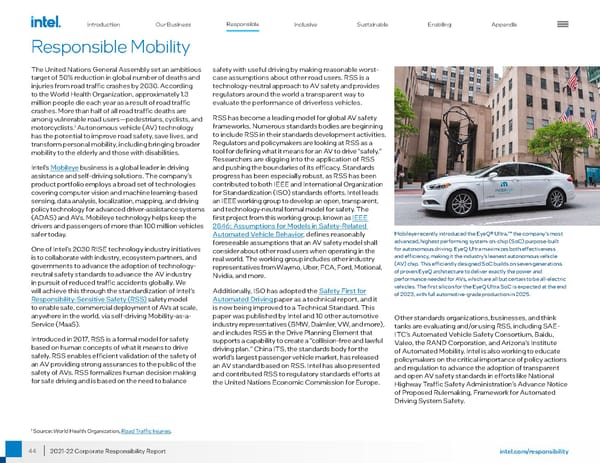44 2021-22 Corporate Responsibility Report Responsible Mobility The United Nations General Assembly set an ambitious target of 50% reduction in global number of deaths and injuries from road traffic crashes by 2030. According to the World Health Organization, approximately 1.3 million people die each year as a result of road traffic crashes. More than half of all road traffic deaths are among vulnerable road users—pedestrians, cyclists, and motorcyclists. 1 Autonomous vehicle (AV) technology has the potential to improve road safety, save lives, and transform personal mobility, including bringing broader mobility to the elderly and those with disabilities. Intel ’ s Mobileye business is a global leader in driving assistance and self-driving solutions. The company ’ s product portfolio employs a broad set of technologies covering computer vision and machine learning-based sensing, data analysis, localization, mapping, and driving policy technology for advanced driver-assistance systems (ADAS) and AVs. Mobileye technology helps keep the drivers and passengers of more than 100 million vehicles safer today. One of Intel ’ s 2030 RISE technology industry initiatives is to collaborate with industry, ecosystem partners, and governments to advance the adoption of technology- neutral safety standards to advance the AV industry in pursuit of reduced traffic accidents globally. We will achieve this through the standardization of Intel ’ s Responsibility-Sensitive Safety (RSS) safety model to enable safe, commercial deployment of AVs at scale, anywhere in the world, via self-driving Mobility-as-a- Service (MaaS). Introduced in 2017, RSS is a formal model for safety based on human concepts of what it means to drive safely. RSS enables efficient validation of the safety of an AV providing strong assurances to the public of the safety of AVs. RSS formalizes human decision making for safe driving and is based on the need to balance safety with useful driving by making reasonable worst- case assumptions about other road users. RSS is a technology-neutral approach to AV safety and provides regulators around the world a transparent way to evaluate the performance of driverless vehicles. RSS has become a leading model for global AV safety frameworks. Numerous standards bodies are beginning to include RSS in their standards development activities. Regulators and policymakers are looking at RSS as a tool for defining what it means for an AV to drive “ safely. “ Researchers are digging into the application of RSS and pushing the boundaries of its efficacy. Standards progress has been especially robust, as RSS has been contributed to both IEEE and International Organization for Standardization (ISO) standards efforts. Intel leads an IEEE working group to develop an open, transparent, and technology-neutral formal model for safety. The first project from this working group, known as I EEE 2846: Assumptions for Models in Safety-Related Automated Vehicle Behavior , defines reasonably foreseeable assumptions that an AV safety model shall consider about other road users when operating in the real world. The working group includes other industry representatives from Waymo, Uber, FCA, Ford, Motional, Nvidia, and more. Additionally, ISO has adopted the Safety First for Automated Driving paper as a technical report, and it is now being improved to a Technical Standard. This paper was published by Intel and 10 other automotive industry representatives (BMW, Daimler, VW, and more), and includes RSS in the Drive Planning Element that supports a capability to create a “ collision-free and lawful driving plan. “ China ITS, the standards body for the world’s largest passenger vehicle market, has released an AV standard based on RSS. Intel has also presented and contributed RSS to regulatory standards efforts at the United Nations Economic Commission for Europe. Other standards organizations, businesses, and think tanks are evaluating and/or using RSS, including SAE- ITC ’ s Automated Vehicle Safety Consortium, Baidu, Valeo, the RAND Corporation, and Arizona ’ s Institute of Automated Mobility. Intel is also working to educate policymakers on the critical importance of policy actions and regulation to advance the adoption of transparent and open AV safety standards in efforts like National Highway Traffic Safety Administration ’ s Advance Notice of Proposed Rulemaking, Framework for Automated Driving System Safety. Mobileye recently introduced the EyeQ® Ultra,™ the company’s most advanced, highest performing system-on-chip (SoC) purpose-built for autonomous driving. EyeQ Ultra maximizes both effectiveness and efficiency, making it the industry’s leanest autonomous vehicle (AV) chip. This efficiently designed SoC builds on seven generations of proven EyeQ architecture to deliver exactly the power and performance needed for AVs, which are all but certain to be all-electric vehicles. The first silicon for the EyeQ Ultra SoC is expected at the end of 2023, with full automotive-grade production in 2025. 1 Source: World Health Organization, Road Traffic Injuries . Introduction Our Business Inclusive Sustainable Enabling Appendix Responsible intel.com/responsibility
 Intel Corporate Responsibility Report Page 43 Page 45
Intel Corporate Responsibility Report Page 43 Page 45